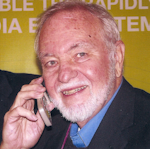Single-Chip Millimeter-Wave Transceivers Target Small-Cell Backhaul
The heterogeneous network (HetNet) of small cells promises faster download speeds and greater cellular capacity to handle the growing demands of smart-phone and tablet users. One of the greatest challenges of building out such a network is backhaul, the connection from the small cell back to the carrier switching network. Wireless backhaul appears to be a better solution than fiber for the complex mix of small-cell locations. Infineon’s BGT60, BGT70, and BGT80 single-chip millimeter wave RF transceivers make this solution practical, smaller, and more affordable.
The transceivers cover the 57- to 64-GHz (V-band), 71- to 76-GHz (E-band), and 81- to 86-GHz (E-band) frequency ranges, respectively. Each chip is a complete silicon-germanium (SiGe) RF front end consisting of a low-noise amplifier (LNA), power amplifier (PA), mixers, programmable gain amplifier (PGA), voltage controlled oscillator (VCO), and related blocks (see the figure). The transceivers are direct conversion/zero IF types, so they connect via balanced I and Q connections to/from a baseband processor for the appropriate protocol. Channel tuning and TX/RX selection is made via an SPI port. The design is based on Infineon’s experience with 24-GHz and 77-GHz auto radar chips. With appropriate standards, the chips can deliver the 1-Gbit/s data rates demanded of most small-cell designs.
The chips support both frequency division duplex (FDD) and time division duplex (TDD) access systems in full or half duplex modes. They also support quadrature phase-shift keying (QPSK) and M-ary quadrature amplitude modulation (M-QAM) with an IF bandwidth of 100 MHz. The typical transmitter power output is in the 10- to 13-dBm range, and the receiver noise figure is 7 dB. A built-in self test (BIST) feature provides for RF testing during production. Both power detection and thermal sensors are fully integrated.
Production on these chips has started, and samples and evaluation kits are expected to be available in December.
Infineon Technologies
This file type includes high resolution graphics and schematics when applicable.


